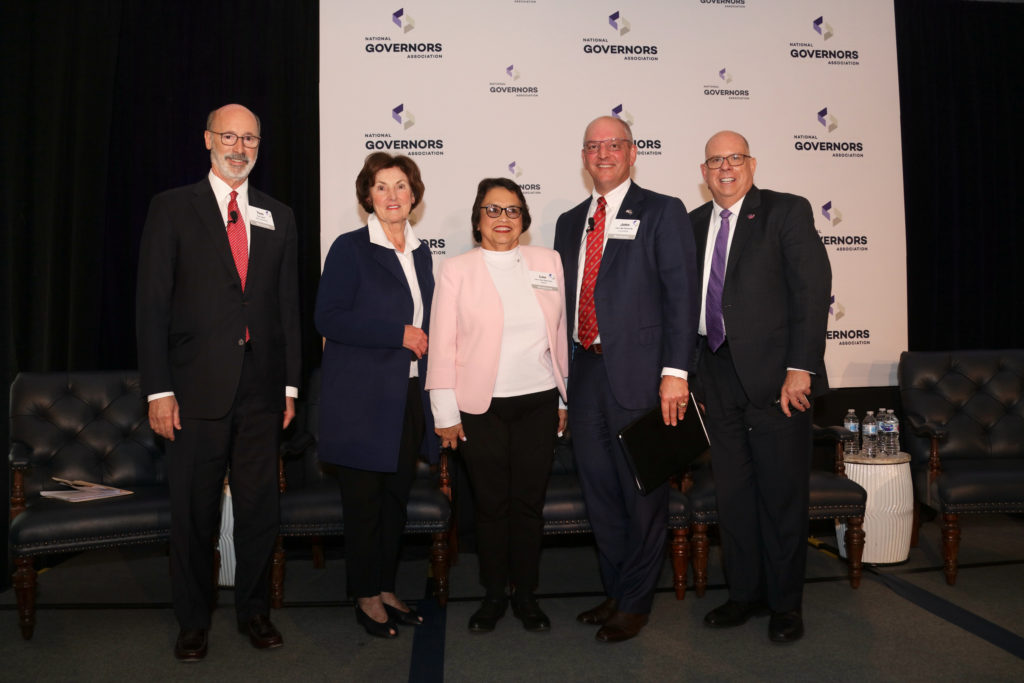Governors will continue to be at the forefront leading the implementation of these historic infrastructure investments.
by Glenn Grimshaw
The National Governors Association convened a bipartisan group of Governors and staff over three days in Annapolis, Maryland to kick off implementation of the recently enacted bipartisan Infrastructure Investment and Jobs Act (IIJA). The Summit brought together over 200 participants including Governors from six states and territories, state leadership and agency staff, federal Administration officials, NGA Partners, and industry stakeholders. Productive and informative discussions were held throughout the event, both on-stage and off, and the NGA thanks participants for making the Summit a great success.
The overriding objective of the Summit was to discuss plans to deploy new federal dollars to improve infrastructure in states and territories in the context of the recently signed IIJA. While numerous issues were discussed over the course of the three days, several key themes stood out during the sessions, including partnerships, rulemaking, workforce development, broadband and alternative fuel vehicles.

There was a robust discussion throughout the Summit on the critical importance of states and territories forging partnerships while implementing the IIJA. At a Governors Panel featuring Arkansas Governor and NGA Chairman Asa Hutchinson, Guam Governor Lourdes “Lou” Leon Guerrero, Louisiana Governor John Bel Edwards, Maryland Governor Larry Hogan, and Pennsylvania Governor Tom Wolf, Governor Wolf emphasized the need to attract private sector money to augment funding from the Federal Government, a sentiment Maryland Governor Larry Hogan echoed, observing that there is an almost unlimited amount of investment dollars that can be leveraged through public-private partnerships (P3s) to complete infrastructure projects. Other panelists noted that the final IIJA incorporated new P3 provisions which can foster not only financing opportunities but also innovation and creativity from the private sector. Guam Governor Leon Guerrero noted that her focus was on leveraging the opportunity from increased federal support to enhance economic diversification on her Pacific Island. The concept of P4s, which include philanthropic actors, was discussed as a way to leverage underutilized transportation rights of way to jointly meet infrastructure, environmental and funding goals. White House Senior Advisor and Infrastructure Coordinator Mitch Landrieu, highlighted his imperative to build upon partnerships across the local, state and federal levels of government when implementing the IIJA.
The importance of sound rulemaking was also a prominent theme. Louisiana Governor John Bel Edwards said that the Federal Government’s rules for the new IIJA programs should be flexible and developed with input from stakeholders that will implement the new law. During a panel session on Building our Transportation Future, Federal Transit Administration Administrator Nuria Fernandez noted that the Department of Transportation is looking at what can be done to harmonize existing rules and processes and ensure that they are not roadblocks. During the same session, Stephanie Pollack, Acting Administrator, Federal Highway Administration (FHWA), highlighted that the FHWA has issued a request for information to solicit suggestions from the public and stakeholders on how to facilitate their implementation of the IIJA, noting that “we want our guidance to meet the needs of the people that will access that money.”
Skilled labor and workforce development challenges were raised throughout the proceedings. Workforce issues featured heavily in a session on supply chains, with panelists discussing the need for innovative policies and regulatory reforms to entice workers back into the labor force. In a session on building resilient energy infrastructure, Melissa Lavinson, a Senior Vice President at Exelon Corporation and Aamir Paul, U.S. Country President for Schneider Electric, discussed actions they are considering to facilitate the development of their workforce, including partnering with community colleges, looking at infrastructure academies and offering training on-the-job to allow employees to progress to the next tier. In the broadband context, Veneeth Lyengar, Executive Director for Broadband Development and Connectivity at Louisiana’s ConnectLA broadband office, said the IIJA presents a great opportunity for those who are not interested in attending a four-year college to pursue a career, and that Louisiana is encouraging high schools to partner with the local community college technical systems and with providers and the co-ops to create workforce plans.
While day three of the Summit was dedicated to exploring how states and territories can best position themselves to make the most of significant IIJA funding for broadband expansion, the topic was a focus throughout the event. During the Governors Panel on day one, Arkansas Governor Asa Hutchinson said that the infrastructure funds are going to be “critically important to help us get to where we need to be in rural broadband.” In separate remarks, United States Agriculture Secretary Tom Vilsack echoed Governor Hutchinson’s sentiments, stating that his department is excited about what the bill will mean for rural America. Scott Pulsipher, President of Western Governors University, emphasized the outcomes of expanded broadband to improving digital literacy, digital skills and ultimately the modern economy. Evelyn Remaley, Acting Assistant Secretary, National Telecommunications and Information Administration (NTIA) – the agency tasked with distributing a significant portion of the IIJA broadband funding – noted that the NTIA is focused on addressing a raft of challenges, including speeds, digital equity, affordability, and end-user capabilities. She said that states and territories should be in a position to demonstrate how they plan to piece together the different sources of broadband funding and emphasized the need to start the process of mapping the location of unserved and underserved communities before programs begin to be rolled out.

There was a lot of excitement around alternative fuel vehicles at the event. Attendees had the opportunity to ride electric school buses supplied by Thomas Built Buses and Lion Electric Co. to a reception featuring electric and hydrogen vehicles provided by Hyundai, Stellantis, and Rivian. In remarks before the reception, Oregon Governor Kate Brown underlined that the signing of the infrastructure package provided an incredible opportunity for states to double down on electric vehicle infrastructure. A panel held on building resilient energy infrastructure emphasized the need to upgrade digital and hard assets in the U.S. energy grid to accommodate greater electrification, including the growth of electric vehicles. The possibilities of using state rights of way to accommodate electric vehicle charging stations and supporting solar development were also discussed.
Governors will continue to be at the forefront leading the implementation of these historic infrastructure investments. Looking forward, NGA will continue working with states and territories in the new year on these and other key issues raised during the Infrastructure Summit.












